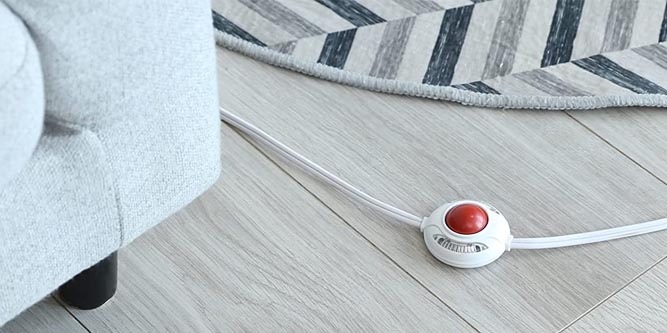The modern home is filled with electronic devices, from TVs to kitchen appliances to PCs and laptops. In many ways, these electronics are what make our homes different than those of our parents and grandparents. But a lot of times, there isn’t a power outlet near the device you want to plug in. In that case, you have a couple of options. You can either install a new power outlet, or use an extension cord.
Most extension cords are pretty straightforward. You plug one end into your power outlet, and you plug your device into the other end. And in most cases, that’s all you’re really going to need. But what if you want your extension cord to come with its own switch? This isn’t always necessary. For example, you might simply plug into an outlet that’s controlled by a wall switch. Then again, you might not have that option. And for certain electronics, such as lamps, it can be nice to have a built-in switch. In that case, you’ll want to use an extension cord with a foot switch.
We’re about to review three of the top foot switch extension cords on the market. We’ll start with the GE Extension Cord with Footswitch. This is a simple two-prong extension cord, with rotating outlets on the end. Next, we’ll look at the Uninex Grounded Extension Cord with Foot Switch. This is a heavy-duty extension cord with extra insulation and three-prong plugs. Last but not least, we’ll examine the DEWENWILS Foot Switch Power Cord. This is another two-prong cord with rotating outlets, but it has built-in indicator lights. Which one is right for you? To find out, we’ll have to take a closer look at all of their features. Let’s take a deeper dive, and see what we discover!
The Basics of Extension Cords
Before we go any further, it’s worth exploring the features of a good extension cord. How do you separate a high-quality cord from one that isn’t worth buying? There’s no single, hard and fast rule. After all, there are many applications for extension cords, so you might want different features. That said, there are a few important considerations to keep in mind.
Finding the Right Length
Of all the different features of an extension cord, the length is probably the most obvious. Go into any hardware store, and all the cords will have the length prominently displayed. But how long of a cord do you need? Your first instinct might be to choose the shortest cord that will do the job. After all, you don’t want to overspend, so why would you buy a longer cord than you need? As it turns out, there are a few good reasons to buy a longer cord.
To begin with, you don’t want your cord getting pulled too tight. If it’s under tension, the cord could get damaged, especially where it connects to the plug. A cord that’s hanging loosely, on the other hand, is going to be under much less stress. This means that – at least in theory – it should last longer.
Another reason to choose a longer cord is that you might end up coming up short. In that case, you’d end up needing to daisy-chain more than one cord. This is a bad idea. When you use multiple cords, you’re adding resistance to the line with each plug. This resistance has two significant effects. First, it reduces the amount of power that reaches your device. Daisy-chain enough cables, and you won’t have enough power for your electronics. The other effect is even worse. Resistance adds heat, which can cause the cord to melt, or even start a fire.
The third reason to choose a longer cord is purely practical. Eventually, you might want to repurpose it. Even if the cord is long enough for today’s use, it may not be long enough for tomorrow’s. If you want a more versatile cord, choose a longer option, and you’ll be better off.
Choosing the Right Amperage
Along with voltage and wattage, amperage is a measure of how much power a cord can deliver. The more amperage, the more powerful of a device you can power. Standard North American outlets have a rating of 15 amps. Some circuit breakers and heavier cables can even provide 20 amps. This is rarely necessary, but can sometimes be needed for heavy-duty power tools.
The ideal extension cord will deliver that same 15 amps, but that’s not always practical. A 15-amp cord requires heavy wires and a lot of insulation. Interior cords in particular often have a lower rating in order to maintain a slimmer form factor. The cords we’re looking at today all have a rating of 13 amps, which is sufficient for most purposes. You won’t be able to run power tools or use a space heater. But for just about anything else, you’re going to have plenty of juice. Voltage and wattage are less of an issue. All of these cords surpass the capacity needed for any standard outlet.
Permanent or Temporary Use?
Another significant concern is whether the extension cord is being used for a permanent installation. In point of fact, this is rarely advisable. Building codes and UL ratings still do not allow for permanent use of extension cords. If you’re running a business and you use a cord permanently, you could even be fined. The reason is that extension cords deteriorate over time. Eventually, an old, dried-out cord becomes a fire hazard.
If you own your own house, there’s an easy solution. Use an extension cord temporarily, while you work on installing a new outlet. An electrician can do the job for you in a few hours, and it will be much safer than a permanent extension cord. And if you need a switch, you can have the electrician wire a switch in, too.
Then again, there are situations where wiring in an outlet is not an option. What if you have a stone or brick wall, and can’t run wiring through the interstitial space? More commonly, what if you’re renting? Unless you have an exceptional relationship with your landlord, they’re not likely to install a new outlet on request. In these and similar situations, you may have no alternative other than to use a permanent extension cord. This is yet another reason to choose a longer cord than you actually need. With a longer cord, there’s less wear and tear, which lessens the safety risk.
If you’re planning to use a cord permanently, look for one with thicker insulation. In most cases, that’s going to be a round cord, since round cords have more space for it. The beefier the cord, the longer it’s going to last. And regardless of what cord you’re using, it’s wise to inspect them periodically. If you see any cracking in the insulation, you know it’s time to buy a new cord.
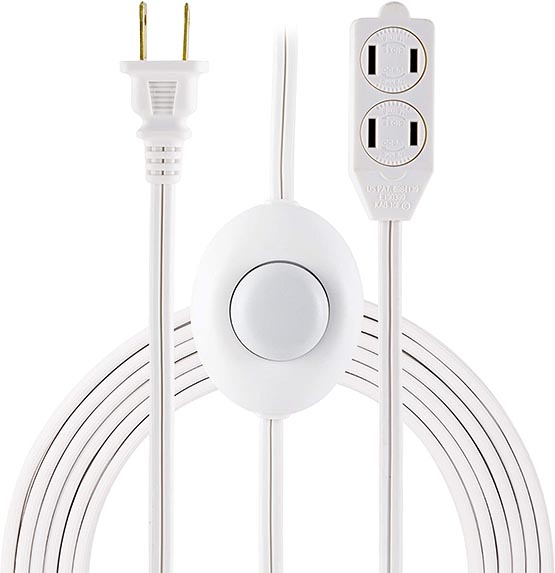
GE Extension Cord with Footswitch
As a company, General Electric needs no introduction. They’re well-known for making all kinds of electronics, from dishwashers to power outlet motion sensors. So when we were looking for the best extension cords, GE seemed like an obvious place to start.
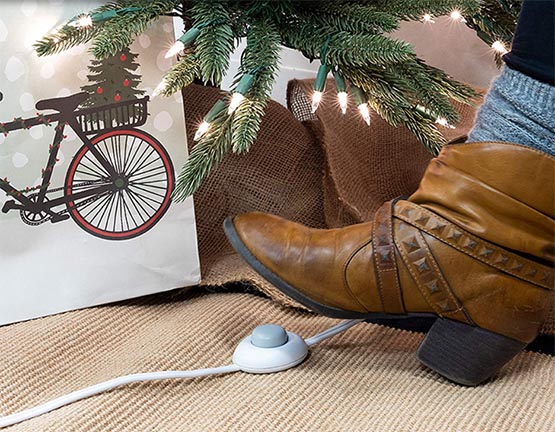
The GE Extension Cord with Footswitch is a simple, straightforward cord. It’s flat and white, with a length of nine feet. At one end, there’s a simple two-prong plug which plugs into your power outlet. At the other end, there’s a little block with three 2-prong sockets. These are oriented with two on one side, and the third on the other. That way, they can be staggered, which reduces the overall size of the block. These sockets are specifically designed for safety. When you rotate them, the openings actually close off, so you can’t plug anything in. This makes them safe around babies, where other cords can present a hazard. In addition, the sockets are polarized. As a result, you can plug in even sensitive electronics with polarized safety plugs.
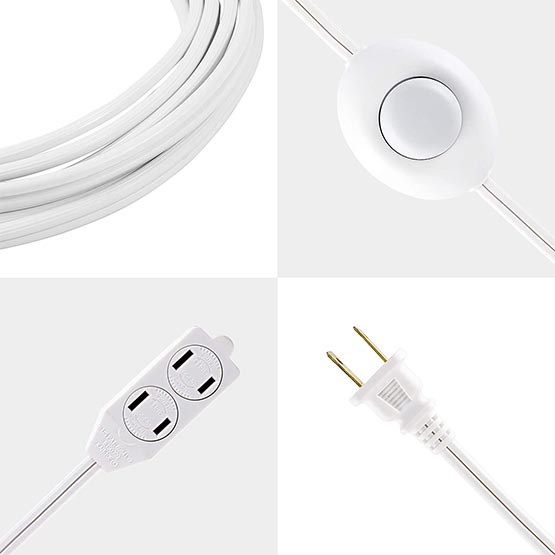
In the middle of the cord, there’s a white footswitch. It has a round housing, with a flat bottom. This makes it easy to keep in place, since it won’t be constantly shifting around. The switch itself is solid plastic, and it makes a nice click when you trip it. The cord’s power rating is 125 volts, 1,625 watts, and 13 amps. The first two exceed the capabilities of a standard outlet, so they don’t present any limitation. The 13 amp power is enough for most household electronics. If you’re plugging in low-powered devices like Christmas lights, you can easily use all three outlets.
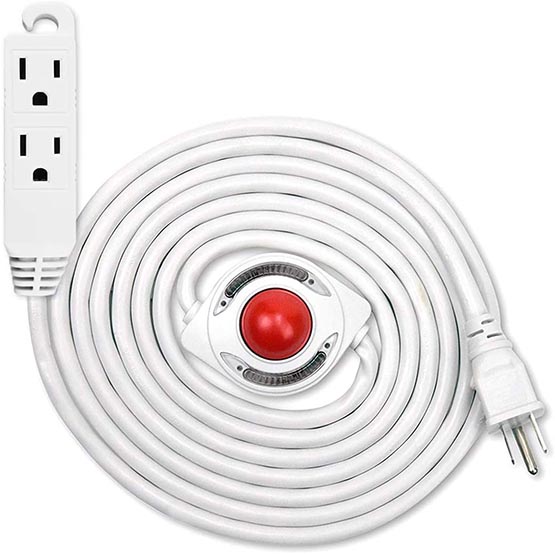
Uninex Grounded Extension Cord with Foot Switch
The Uninex Grounded Extension Cord with Foot Switch is a rugged, heavy-duty cord for more demanding uses. The wire itself is 16-gauge, which is heavier than many indoor cords. We’re not saying you can run power tools with it. With 13 amps of total power, it’s not actually more powerful than either of our other choices. That said, it’s more durable, so you can use it in applications where it needs to take some abuse. And with 125 volts and 1,625 rated watts, it’s suitable for any interior outlet.
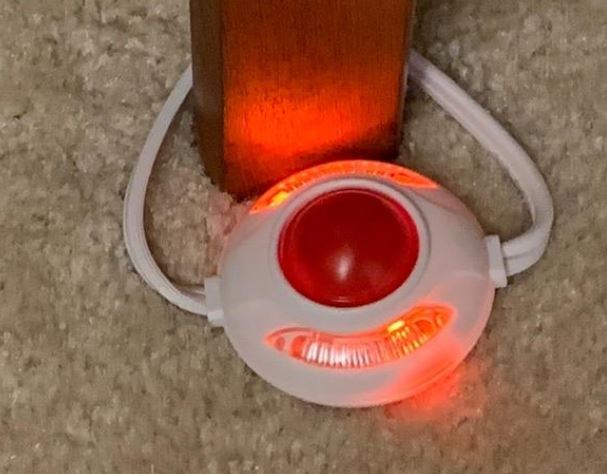
At one end of the cord, there’s a 3-prong grounded plug. The 15-foot cord then extends four feet to the footswitch, and eleven more to the far end. The far end has a little block on it, with three grounded power outlets. So even if you need a three-prong outlet, you’re going to be covered. The footswitch has a black housing that matches the cord, but the switch itself is bright red. This gives you plenty of visibility if you’re fumbling around in a dimly-lit room. The switch also has two built-in indicator lights, one on each side. The first will light up whenever the cord is plugged in. The second will turn on when the switch has been powered on.
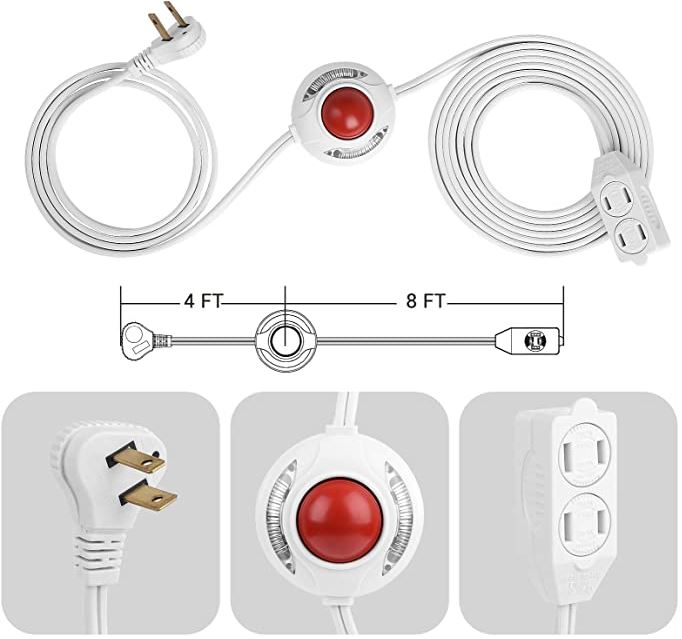
DEWENWILS Foot Switch Power Cord
DEWENWILS specializes in cords and other power-related equipment. We recently reviewed their surge protector with built-in timer, and we were pleased. So it made sense to try out their extension cord.
The DEWENWILS Foot Switch Power Cord is white in color, with a flat profile and a length of 12 feet. The footswitch is positioned four feet from the plug end. The cord then extends eight more feet to a power block. This block houses three 2-prong outlets, which are compatible with polarized plugs. They also rotate and close off, which is a great safety feature for babies and small children. The male plug is also a 2-prong, as well as being polarized. The nice thing about this plug is that it’s flat, with the wire entering from the side at a 45-degree angle. This makes it easy to position behind couches and other furniture.
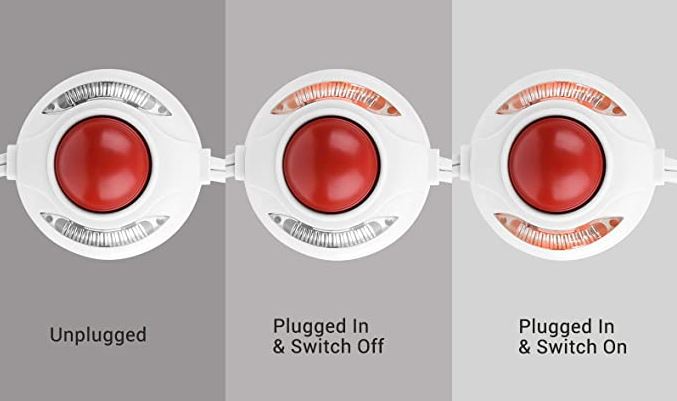
The cord rating is 13 amps, 125 volts, and 1,625 watts, just like the other two. It’s also a 16-gauge, so it’s nice and tough. With the exception of being white instead of black, the footswitch is the same as the one on the Uninex cord. It has the same red toggle, and the same two indicators that let you know the cord’s status.
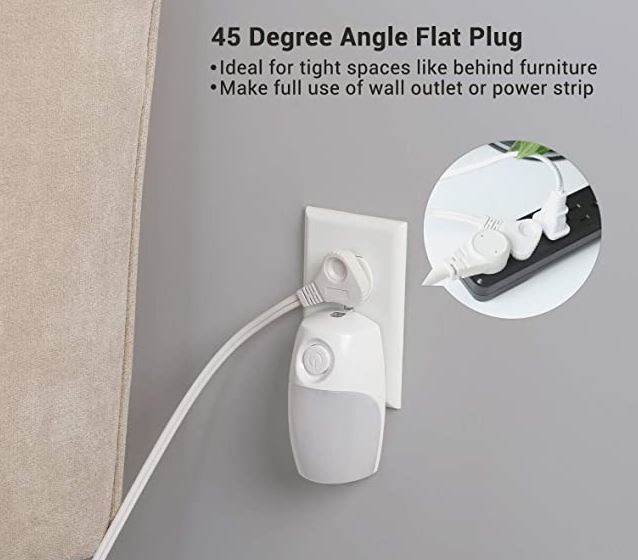
Final Verdict
So, which one of these footswitch extension cords is the right one for you? It all depends on what you need. The GE Extension Cord with Footswitch is the most basic option. It’s nine feet long, with three two-prong outlets and a simple switch. If you’re not looking for anything fancy, you’ll be happy with this one.
If you need to run grounded electronics, you need the Uninex Grounded Extension Cord with Foot Switch. Why? Because it’s the only one with grounded outlets. Not only that, but it’s heavy-duty and well-insulated. For your more demanding electronics, this cord is an excellent choice.
The DEWENWILS Foot Switch Power Cord is a lot like the GE cord, but it’s three feet longer. As an added bonus, the footswitch has indicator lights, so you know when it’s plugged in and working. The plug also has a low profile, which makes it a good choice if your outlet is behind some furniture.
Meet Ry, “TechGuru,” a 36-year-old technology enthusiast with a deep passion for tech innovations. With extensive experience, he specializes in gaming hardware and software, and has expertise in gadgets, custom PCs, and audio.
Besides writing about tech and reviewing new products, he enjoys traveling, hiking, and photography. Committed to keeping up with the latest industry trends, he aims to guide readers in making informed tech decisions.

